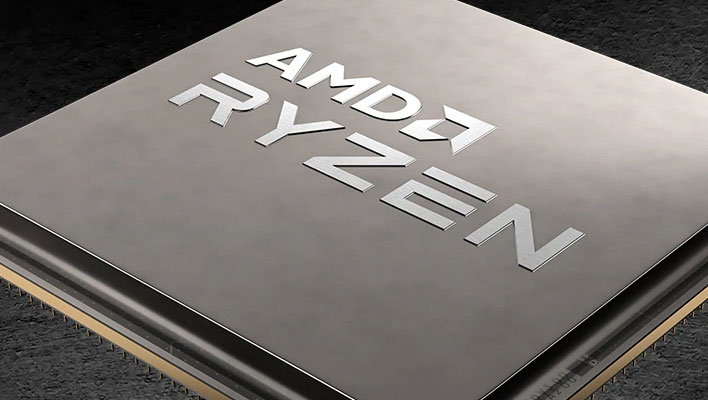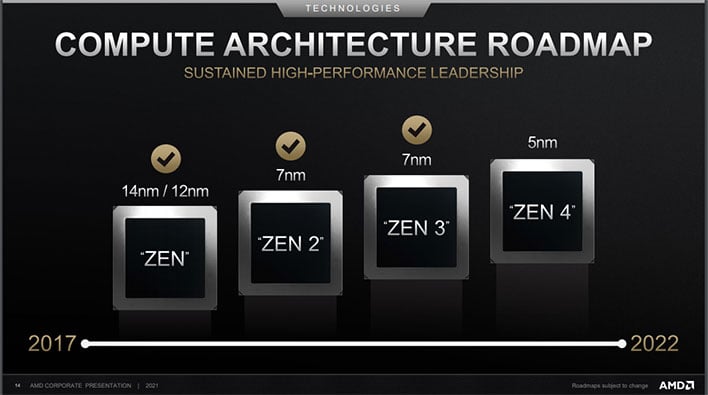AMD Zen 4 AM5 Platform Rumored With LGA 1718 Socket, Dual-Channel DDR5 Support

There are some potentially exciting processor launches coming up later this year (Alder Lake-S) and presumably early next year (Zen 4). Next-gen platforms from AMD and Intel will bring some new and upgraded technologies to the forefront, and as it applies to the former, some information about its upcoming AM5 platform for Zen 4 has seemingly leaked out.
AMD has not been shy about mentioning Zen 4 by name, and even said more than a year ago that, on the server side, it's Zen 4 "Genoa" EPYC processors will "support next-generation memory and I/O sub systems for AI and HPC workloads." It has also not been bashful about putting out public roadmaps highlighting Zen 4 in the distance, like this one...

To that end, AMD has already confirmed Zen 4 will be built on a 5-nanometer manufacturing process. We can also reasonably assume a decent bump in instructions per clock (IPC) performance and better power efficiency, both of which are typical when shifting to a smaller node. And during an interview with The Street last year, AMD executive vice president Rick Bergman noted Zen 4 will have a "long list of things, where you look at everything from the caches, to the branch prediction, [to] the number of gates in the execution pipeline."
"Every is scrutinized to squeeze more performance out," Bergman added.
Most of the specific details surrounding Zen 4 have not been officially revealed. Unofficially, however, leaks and rumors abound, the latest of which offers up some basic details on the AM5 platform that Zen 4 will run on.
Known leaker ExecutableFix stated on Twitter that the AM5 desktop platform for Zen 4 will feature an LGA 1718 socket design, with the same 40mm x 40mm size as AM4 (suggesting that existing CPU coolers should be compatible with little fuss).
If that ends up being true, it will mark a shift from using a pin grid array (PGA) socket to a land grid array (LGA) socket, the latter of which Intel has been using for quite some time. And as for the pin count, we're looking at 18 more pins compared to Alder Lake's LGA 1700 socket.
As expected, AMD will launch a new 600-series chipset with dual-channel DDR5 memory support. However, if the information is accurate, AMD will stick with PCI Express 4.0 on the consumer side, and only leverage PCI Express 5.0 for its next-generation EPYC processors, where the upgraded bus specification could have a bigger impact.
Today's platforms are not really making full use of PCI Express 4.0 (Intel only just recently got around to supporting it on the desktop, with Rocket Lake), so it's not a huge deal. However, it will give Intel a bragging point—whereas AMD was first to PCIe 4.0, Intel will be first to PCIe 5.0 with Alder Lake-S.
There's also the fact that the latest high-speed M.2 form factor NVMe Gen 4 SSDs are starting to saturate the PCIe 4.0 x4 bus, with some drives pushing speeds just north of 7,000MB/s (the theoretical max bandwidth for four lanes of traffic is 8,000MB/s).
Ah well, the upgrade to DDR5 is more interesting anyway. Initial DDR5 memory kits are likely to be around 4,800MT/s and 6,400MT/s, though at least one RAM maker has talked about eventually releasing a DDR5-10000 kit. It will be interesting to see how DDR5 impacts performance.
The hardest part is waiting. Or at least it would be under normal circumstances. Given the shortage of silicon and difficulty buying certain parts (like the highest end CPUs from AMD, and pretty much any graphics card on the planet), now is not the ideal time to build a PC.


